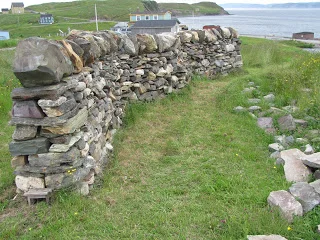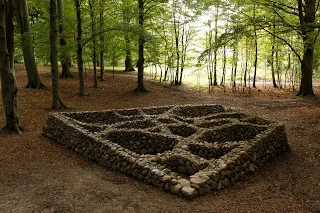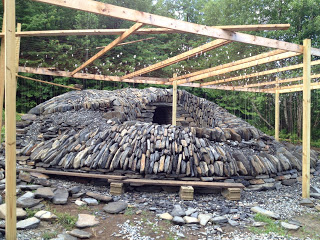We must have done something right in a former life to get so lucky with the week’s weather during the recently completed English Harbour Arts Centre (EHAC) dry stone workshop. Seven participants from two provinces and three states worked under nearly rain-free skies for five days designing and building long-lasting walls and ephemeral art. Some of us even took a dip in the bay; a rare occurrence in Newfoundland waters.
Read MoreThe last five pages of my notebook are covered in boulder sketches. Each one records the shape and dimensions of a large stone in Edward Tufte’s growing stock yard of material pried loose from ledges on his Hogpen Hill Farm. The pencil sketches are the first step in a method of discovery I’ve employed for designing megalithic constructions since 1981 when I won a NEA grant for studying amphitheaters. From the drawings I fashion ¼” -1’ clay models of the stones. With the clay pieces I can try out a variety of construction configurations before confronting the actual boulders. The small-scale assemblages allow for freedom to experiment with different design concepts.
Read MoreWhen I began building stone features on Richard Epstein’s property more than ten years ago he had a unformed, but long term vision of the space around his cabin. He wanted to keep the sequestered feel of being in the deep woods. He also wanted to armor the slopes surrounding his home with stone. To this end, we began by building a sunken patio to the southeast with stepped paths leading to a pond. A few years later, a raised pyramid, fire pit patio was created to the northeast. Stone steps replaced wood stairs at porch entrances.
Read More"Working hands inform thought and awaken understanding of the art builder's place in the natural world. Undulant lines and patterned spaces are the result of many choices made by the builder who recognizes, and utilizes, the unique character of stone"
- Dan Snow
My time in the eye of the stone has passed. Yesterday saw the final vertical pieces set in the Horse Eye sculpture. Phase One is complete except for two elements being carved by Chris Curtis of West Branch Gallery in Stowe, Vermont. They will be lowered into place at a later date, replacing the styrofoam mock-ups. The carved pieces will represent the “third eyelid.” The third eyelid of a horse is the lightning-fast flap that zips across from the inner corner to seal the eye shut against threat even before the lids can close. It's also the source of lubricating tears.
Read MoreYou have to love a state whose official rock is a petrified “burp.” Large areas of the land that is now the state of Oregon had bubbly, silicic lava periodically flowing out of it for 11 million years. The lava cooled and became buried. Water got into the hardened shell of the gas nodules and brought mineral solutions which eventually turned to agate. Today those geologic anomalies are called “thunder eggs.” Dan Dunn, owner of Alpine Boulder Company, showed me around the inventory of his stone yard. I was amazed by the size and quality of thunder egg, petrified log and basalt column specimens at his Helix, Oregon location. Dan owns or leases properties in Oregon with mineral potential. He prospects for special stones and makes them available to wholesale customers.
Read MoreLaboring in stone-craft is sweaty business even when the summer air temperature is moderate. Ramp the heat up to 95° F (35° C), add the radiant heat steaming off the stones, and I find myself working in a veritable, solar bake oven. The perspiration really starts to flow. Dust swirling around the site sticks to damp clothing and exposed skin. I look like a coal miner by the end of the day. I’m not complaining, though. Extreme heat is preferred over cold. My aging muscles and joints definitely perform better in summer weather.
Read MoreStone hunting for The Tarriance sculpture project recently took me on a 1,300 mile, Oregon road trip. The trail led across dry shrub-lands, over evergreen-spired mountain passes, and along deep river gorges. In the west, three basalt boulders were located in a riverside gravel pit. In the east, slag from an abandoned granite quarry netted the thirty pieces I’ll use to construct the “raft” that the boulders will rest upon.
Read MoreWhile nature abounds all around I try to focus on the work at hand. The methodical labor of setting vertical stone to shape the sculpture requires a steady concentration. Each piece has to slot in between previously set stones, and has to be bedded in the crushed stone so that the top face aligns with the developing form. On the highest portions of the work, I measure the next space to be filled, climb down to find an appropriate stone, hammer shape it if necessary, and climb back up to set it.
Read MoreIt was excavator ballet at Hogpen Hill Farms this week. I had four machines at my disposal for the assembly of stone structures. Under Edward Tufte’s direction, the polite march of table tops created during previous sessions evolved into a stagger of dolmens. The new pieces, inspired by ancient lithic structures, progressed south along a wooded ridge-line in combinations of two, three and four stones.
Read MoreA collaborative design process culminating in the hands-on creation of a dry stone structure. Instruction in design will include site assessment, 3-D modeling and guide frame set up. Instruction in building with loose stone will include identifying each stone’s best use, applying the four basic principles for strong construction, and practicing safe methods for shifting and lifting stone. One day of the workshop will be devoted to working in nature to create a temporary environmental art piece.
Read MoreShowers every day added up to 2” of precipitation and sloppy working conditions at the stone eye project this week. Safety glasses fogged and the mud sucked at my boots but I was glad to be outside making progress on the construction. The lead-sinker hanging guide-point system is proving to be very reliable and flexible. When I need to move a group of points out of the way to pitch stone into the center, I simply swing them up to the wire grid and hook them there temporarily. As I finish an area of stone work I unclip and remove the point lines.
Read MoreA recent chance drive-by along Vermont Route 15 led to the discovery of Jeffersonville Quarry, and a way forward with the stone eye. In less than 36 hours, I’d sourced stone for vaulting the ceiling of the passage, ordered the pieces (which were quickly quarried out by Ken Gillilan) trucked them to the building site, and installed them.
Read MoreIn late autumn of 2011 Gordon Hayward called to say that Teddy Berg had asked him to write a book about her gardens on Rice Mountain in Walpole, New Hampshire. He wanted to know if I’d care to contribute a few essays, and, of course, I said I’d be pleased and honored to do so. ‘Gardening on Granite’ is hot off the presses this month. It’s a large-format book packed with gorgeous photographs and a lovingly told, personal history of a very special place and time.
Read MoreClouds are banking in from the west, bringing the first significant precipitation to Vermont in months. April’s weather has felt positively ‘Southern Californian.’ Under intense sunshine, in powder dry conditions, I got started laying stone on the Stone Eye Project this past week.
Read MoreI laid up another length of Galloway style wall reusing the stone from an adjacent derelict wall. The beauty of what Tony had in mind when he called me last year to begin the project is now clear. With the original wall line shifted away from the trees that had grown up in it, the new wall and mature trees have space to breathe.
Read MoreAnother dry stone landform has begun to take shape at Hogpen Hill Farms. Three dozen “tables” have been assembled along one of the long ribs that constitute the high ground in the woodland park. The directive by Edward Tufte for this piece is to create the illusion of stones floating along the ridge top when viewed from the low ground along each side of the rib, and to establish a strong linear pattern from the bird’s eye view.
Read MoreA physically challenging and intellectually stimulating day of group, outdoor activity that’s not a competitive sport? Yes, it’s possible, and happening this spring on the bucolic grounds of Scott Farm, Dummerston, VT. The Stone Trust is offering workshops in the time-honored craft of building dry stone walls. Participants come from all walks of life to develop and sharpen their skill in creating structurally sound, “stone-only” constructions.
Read More
















